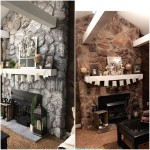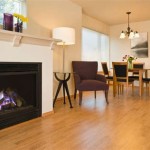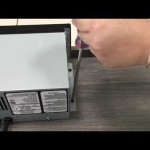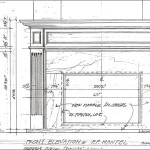Modern Floating Gas Fireplaces: A Synthesis of Design and Function
Modern floating gas fireplaces represent a significant evolution in home heating and aesthetic design. These fireplaces, characterized by their suspended appearance, offer a compelling alternative to traditional hearth-bound units. The appeal lies in their ability to create a focal point within a room while simultaneously conveying a sense of spaciousness and contemporary elegance. Understanding the mechanics, design considerations, and installation requirements of these fireplaces is crucial for homeowners and designers seeking to incorporate them into their living spaces.
The term "floating" refers to the visual effect achieved by the fireplace's mounting system. Rather than resting directly on the floor, the unit is typically affixed to a wall, appearing to hover above the ground. This illusion is often accomplished through the use of concealed brackets, robust support structures, and clever design elements that minimize the visible hardware. The core functionality of a floating gas fireplace remains consistent with other gas-powered units, involving the combustion of natural gas or propane to generate heat and produce a realistic flame effect.
Key Point 1: Design and Aesthetic Versatility
One of the primary advantages of modern floating gas fireplaces is their exceptional design versatility. These units are available in a wide range of styles, shapes, and sizes, allowing for seamless integration into diverse architectural contexts. From minimalist rectangular designs to more elaborate curved or geometric forms, the aesthetic possibilities are extensive. The choice of materials further enhances the design flexibility, with options ranging from sleek stainless steel and brushed metal to elegant glass and stone finishes.
Furthermore, the floating design allows for greater freedom in interior layout. Unlike traditional fireplaces that inherently define a specific spatial arrangement, floating units can be strategically positioned to complement existing furniture arrangements or to create new focal points within a room. Their suspended nature mitigates the visual obstruction often associated with floor-standing fireplaces, thereby contributing to a more open and airy ambiance. The height at which the fireplace is mounted can also be adjusted to suit the room's proportions and the desired viewing angle. This adaptability makes them suitable for both small apartments and expansive living areas.
Modern floating gas fireplaces often incorporate integrated lighting features, further enhancing their aesthetic appeal. LED lighting can be used to accentuate the flame effect, create ambient illumination, or highlight the surrounding wall surfaces. These lighting systems are typically dimmable, allowing homeowners to customize the visual atmosphere to suit their preferences. The integration of smart home technology is also becoming increasingly prevalent, enabling users to control the fireplace's temperature, flame height, and lighting via smartphone apps or voice commands. This level of technological integration further solidifies the modern character of these units.
Beyond their visual impact, modern floating gas fireplaces also offer a tangible improvement in spatial efficiency. By freeing up floor space, they contribute to a more streamlined and uncluttered environment. This is particularly advantageous in contemporary homes where minimalist design principles are often prioritized. The absence of a traditional hearth also eliminates the need for additional safety measures, such as fire screens or hearth extensions, thereby simplifying the overall installation process and reducing the risk of accidental burns.
Key Point 2: Installation and Safety Considerations
The installation of a modern floating gas fireplace requires careful planning and adherence to safety regulations. Due to the suspended nature of the unit, structural integrity is paramount. The wall to which the fireplace is mounted must be sufficiently robust to support its weight, even under dynamic stress conditions. This typically necessitates the use of reinforced wall studs, specialized brackets, and professional installation services.
Gas line connections must be performed by a licensed gas fitter, ensuring compliance with local building codes and safety standards. Proper ventilation is also essential to prevent the accumulation of carbon monoxide and other harmful gases. Most modern floating gas fireplaces are direct-vent models, which means they draw combustion air from outside the building and vent exhaust gases directly outdoors. This eliminates the need for a traditional chimney and minimizes the risk of indoor air pollution. However, the vent system must be properly designed and installed to ensure efficient and safe operation.
Fire safety is a critical consideration when installing any fireplace, including floating gas models. While the risk of accidental burns is lower compared to traditional hearth-based fireplaces, it is still important to exercise caution. The surface temperature of the fireplace enclosure can become quite hot during operation, so it is advisable to keep flammable materials, such as curtains and furniture, at a safe distance. Childproofing measures, such as safety barriers or high mounting positions, may also be necessary to prevent accidental injuries. Regular maintenance, including cleaning and inspection of the gas line and vent system, is crucial for ensuring continued safe operation.
The electrical components of the fireplace, such as the ignition system and lighting, must be installed and wired by a qualified electrician. All electrical connections must comply with local electrical codes and be properly grounded to prevent electric shock. Integrated smart home features should also be configured and tested to ensure seamless and secure operation. In some jurisdictions, a building permit may be required before commencing installation work. It is essential to consult with local building authorities to determine the specific permitting requirements and to ensure compliance with all applicable regulations.
Key Point 3: Operational Efficiency and Environmental Impact
Modern floating gas fireplaces are designed to offer a balance of heating performance and energy efficiency. While they are primarily intended for aesthetic purposes, they can also provide supplemental heating to a room. The heating capacity of a gas fireplace is typically measured in British thermal units (BTUs), and models are available with varying BTU ratings to suit different room sizes and heating needs. To optimize energy efficiency, many modern units incorporate features such as thermostatic controls, programmable timers, and zone heating capabilities. These features allow users to regulate the fireplace's heat output and operating schedule to minimize energy consumption.
The environmental impact of gas fireplaces is a subject of ongoing debate. While natural gas and propane are cleaner-burning fuels compared to wood or coal, they still produce greenhouse gas emissions. However, advancements in fireplace technology have led to significant improvements in combustion efficiency and emission control. Direct-vent models, in particular, are designed to minimize the release of pollutants into the atmosphere. Some manufacturers also offer models that are certified by independent organizations, such as the Environmental Protection Agency (EPA), to meet stringent emission standards.
The life cycle assessment of a gas fireplace also factors into its overall environmental impact. The extraction, processing, and transportation of natural gas and propane contribute to greenhouse gas emissions and other environmental impacts. The manufacturing of the fireplace unit itself also consumes energy and resources. However, the long lifespan of a well-maintained gas fireplace can help to offset these initial impacts. Proper maintenance and responsible disposal of the unit at the end of its service life are also crucial for minimizing its environmental footprint.
Homeowners seeking to further reduce the environmental impact of their gas fireplace can consider alternative fuel sources, such as renewable natural gas (RNG) or propane derived from sustainable sources. RNG is produced from the decomposition of organic waste and can be used as a drop-in replacement for conventional natural gas. Sustainable propane is derived from renewable feedstocks, such as vegetable oils and animal fats. While these alternative fuels are not yet widely available, they represent a promising pathway towards a more sustainable heating solution. Additionally, supplementing the fireplace with other energy-efficient heating systems, such as heat pumps or solar thermal collectors, can further reduce reliance on fossil fuels.

Suspended Modern Fireplaces

Focus Design Fireplaces Stoves Modern Barbecues

Suspended Modern Fireplaces

Suspended Modern Fireplaces

Surprising Facts About Gas Designer Fireplaces Modus

Aurora Suspended Fires The Aether Urban Fireplaces

Advantages Disadvantages Of A Hanging Gas Fireplace Modus Fireplaces

Gyrofocus Gas Floating Fireplace

Suspended Modern Fireplaces Floating European Home Outdoor Fireplace

Rethink Fireplace Design With A Modern Floating Hearth
Related Posts








